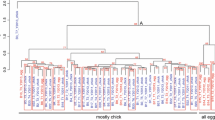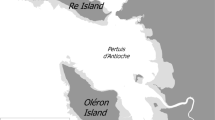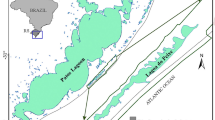Abstract
Optimizing foraging strategies for searching and handling food could be decisive in the survival of migratory shorebirds, which depend on the food supply they find at their stopover sites. Shorebirds are opportunistic feeders that can exhibit inter- and intraspecific variations in foraging behavior associated with bill morphology, the type of prey to be captured, and the type of substrate to be explored. Few studies describe the feeding behaviors of migratory shorebirds in the Americas, so complementation is still required. Through a systematic review of Scopus, Web of Science, and SciELO databases, we analyzed papers published from 1989 to 2021 that investigate the migratory shorebirds’ feeding behaviors in their non-breeding areas in the Americas. We considered 31 articles with 14 descriptions of behaviors. We found that 11 out of 35 species have not yet been studied in this area of ecology and none have been studied on the Pacific coast of South America or on the mid-continental route that crosses the Amazon region. The shorebirds with the highest reported behaviors are Arenaria interpres and Calidris minutilla. Pecking and probing are the most common behaviors in Charadriidae and Scolopacidae families. The rest of the behaviors can likely be extrapolated to other species of the genus; however, it is necessary to expand studies in this field of animal behavior by applying new technologies and including other stopover sites. Unfortunately, many shorebird species in the Western Hemisphere exhibit population declines and understanding the use of these food resources can help guide conservation and responsible development decisions.


Similar content being viewed by others
References
Altmann J (1974) Observational study of behavior: sampling methods. Behaviour 49:227–267
Andrei AE, Smith LM, Haukos D, Johnson WP (2007) Behavior of migrant shorebirds in saline lakes of the Southern Great Plains spend most of their time feeding e resting. Waterbirds 30:326–334. https://doi.org/10.1675/1524-4695(2007)030[0326:BOMSIS]2.0.CO;2
Angarita-Báez JA (2022) Ecologia e comportamento alimentar das aves limícolas no sul do Brasil. MSc. Dissertation, Universidade Federal do Rio Grande do Sul
Angarita-Báez JA, Carlos CJ (2021) Record of interspecific kleptoparasitism by white-rumped sandpiper Calidris fuscicollis in south Brazil. Wader Study 128:288–289. https://doi.org/10.18194/ws.00254
Antas PT (1983) Migration of Nearctic shorebirds (Charadriidae and Scolopacidae) in Brazil-flyways and their Seasonal Use. Wader Study 39:52–56
Baker MC (1973) Stochastic properties of the foraging behavior of six species of migratory shorebirds. Behaviour 45:242–270
Barbieri E, Esparza KAÁ (2022) Migrant birds present on Ilha Comprida, southern coast of the state of São Paulo. Ocean Coastal Res 71:e23001. https://doi.org/10.1590/2675-2824071.22030eb
Barbosa A, Moreno E (1999) Evolution of foraging strategies in shorebirds: an ecomorphological approach. Auk 116:712–725. https://doi.org/10.2307/4089332
Boere GC, Stroud DA (2006) The flyway concept: what it is and what it isn't. In: Boere GC, Galbraith CA, Stroud DA (eds) Waterbirds around the world. The Stationery Office, Edinburgh, pp 40–47
Brabata G, Carmona R (1999) Conducta alimentaria de cuatro especies de aves playeras (Charadriiformes: Scolopacidae) en Chametla, B.C.S. México Rev Biol Trop 47:239–243
Brockmann HJ, Barnard CJ (1979) Kleptoparasitism in birds. Anim Behav 27:487–514. https://doi.org/10.1016/0003-3472(79)90185-4
Brown SC, Hickey C, Harrington BA, Gill R (2001) United States shorebird conservation plan. Manomet Center for Conservation Sciences, Manomet, Massachusetts
Burger J (2018) Use of intertidal habitat by four species of shorebirds in an experimental array of oyster racks, reefs and controls on Delaware Bay, New Jersey: avoidance of oyster racks. Sci Total Environ 624:1234–1243. https://doi.org/10.1016/j.scitotenv.2017.12.188
Burton PJK (1972) The feeding techniques of stilt sandpipers and dowitchers. Trans San Diego Soc Nat Hist 17:63–68
Canevari P, Castro G, Sallaberry M, Naranjo LG (2001) Guía de los chorlos y playeros de la región Neotropical. American Bird Conservancy, WWF, Manomet Conservation Science, Asociación Calidris. Santiago de Cali, Colombia
Castillo-Guerrero JA, Fernández G, Arellano G, Mellink E (2009) Diurnal abundance, foraging behavior and habitat use by non-breeding marbled godwits and willets at Guerrero Negro, Baja California Sur, México. Waterbirds 32:400–407. https://doi.org/10.1675/063.032.0304
Cestari C (2009) Foot-trembling behavior in semipalmated plover Charadrius semipalmatus reveals prey on the surface of Brazilian beaches. Biota Neotrop 9:299–301. https://doi.org/10.1590/s1676-06032009000400036
Chesser RT, Billerman SM, Burns KJ, Cicero C et al (2020) Check-list of North American Birds. Am Ornithol Soc. http://checklist.americanornithology.org/taxa. Accessed 10 Feb 2021
Clarivate Analytics (2021) Web of Science Databases. Philadelphia. https://clarivate.com/products/web-of-science/databases/. Accessed 15 June 2021
Clemens RS, Herrod A, Weston MA (2014) Lines in the mud; revisiting the boundaries of important shorebird areas. J Nat Conserv 22:59–67. https://doi.org/10.1016/j.jnc.2013.09.001
Davis-Jr WE (2003) Commensal foraging and a “beater effect” involving ruddy turnstones, sanderlings, least sandpipers, and short-billed dowitchers. Fla Field Nat 313:59–61
Davis-Jr WE (2016) Shorebird behavior on their wintering grounds. Bird Obs 444:266–269
Davis-Jr WE, Jackson JA (2007) Willets kleptoparasitize and use white ibis as "beaters". Wilson J Ornithol 119:758–760
Davis CA, Smith LM (1998a) Behavior of migrant shorebirds in playas of the southern High Plains, Texas. Condor 100:266–276. https://doi.org/10.2307/1370267
Davis CA, Smith LM (1998b) Ecology and management of migrant shorebirds in the Playa Lakes region of Texas. Wildl Monogr 140:3–45
Davis CA, Smith LM (2001) Foraging strategies and niche dynamics of coexisting shorebirds at stopover sites in the southern Great Plains. Auk 118:484–495. https://doi.org/10.1093/auk/118.2.484
De Leon MT, Smith LM (1999) Behavior of migrating shorebirds at North Dakota prairie potholes. Condor 101:645–654. https://doi.org/10.2307/1370194
DiGiacomo PM, Hamner WM, Hamner PP, Caldeira RMA (2002) Phalaropes feeding at a coastal front in Santa Monica Bay, California. J Mar Syst 37:199–212. https://doi.org/10.1016/S0924-7963(02)00202-6
Dingle H (2008) Bird migration in the Southern Hemisphere: a review comparing continents. Emu 108:341–359. https://doi.org/10.1071/MU08010
Durell SEALVD (2000) Individual feeding specialisation in shorebirds: population consequences and conservation implications. Biol Rev 75:503–518. https://doi.org/10.1111/j.1469-185X.2000.tb00053.x
Elner RW, Beninger PG, Jackson DL, Potter TM (2005) Evidence of a new feeding mode in western sandpiper (Calidris mauri) and dunlin (Calidris alpina) based on bill and tongue morphology and ultrastructure. Mar Biol 146:1223–1234. https://doi.org/10.1007/s00227-004-1521-5
Elsevier (2021) Scopus Databases. https://www.scopus.com/home.uri. Accessed 15 June 2021
Estrella SM, Masero JA, Perez-Hurtado A (2007) Small-prey profitability: field analysis of shorebirds’ use of surface tension of water to transport prey. Auk 124:1244–1253. https://doi.org/10.1093/auk/124.4.1244
Fedrizzi CE, Carlos CJ, Campos AA (2016) Annual patterns of abundance of Nearctic shorebirds and their prey at two estuarine sites in Ceará, NE Brazil, 2008–2009. Wader Study 123:122–135. https://doi.org/10.18194/wS00036
Fernandez G, Lank DB (2008) Foraging behaviour of non-breeding western sandpipers Calidris mauri as a function of sex, habitat and flocking. Ibis 150:518–526. https://doi.org/10.1111/j.1474-919X.2008.00812.x
Frank MG, Conover MR (2021) Foraging behavior of red-necked (Phalaropus lobatus) and Wilson’s (P. tricolor) phalaropes on Great Salt Lake, Utah. Wilson J Ornithol 133:538–551. https://doi.org/10.1676/20-00069
Gerwing TG, Kim J, Hamilton DJ, Barbeau MA, Addison JA (2016) Diet reconstruction using next-generation sequencing increases the known ecosystem usage by a shorebird. Auk 133:168–177. https://doi.org/10.1642/AUK-15-176.1
Gill F, Donsker D, Rasmussen P (2021) IOC world bird list (v12:1). https://doi.org/10.14344/IOC.ML.12.1. Accessed 20 Feb 2021
Gillings S, Atkinson PW, Bardsley SL, Clark NA, Love SE, Robinson RA, Stillman RA, Weber RG (2007) Shorebird predation of horseshoe crab eggs in Delaware Bay: species contrasts and availability constraints. J Anim Ecol 76:503–514. https://doi.org/10.1111/J1365-2656.2007.01229.x
Goss-Custard JD, West AD, Yates MG, Caldow RWG et al (2006) Intake rates and the functional response in shorebirds (Charadriiformes) eating macro-invertebrates. Biol Rev 81:501–529. https://doi.org/10.1017/S1464793106007093
Gussoni COA, Guaraldo AC (2006) Comportamento de forrageamento do pernilongo-de-costas-brancas, Himantopus melanurus (Vieillot 1817) (Aves: Recurvirostridae) em Santa Gertrudes, SP, Brasil. Lundiana 7:149–150. https://doi.org/10.35699/2675-5327.2006.23155
Hamilton RB (1975) Comparative behavior of the American avocet and black-necked stilt (Recurvirostridae). Ornithol Monogr 17:1–98. https://doi.org/10.2307/40166701
Iglecia M, Winn B (2021) A shorebird management manual. Manomet, Massachusetts. https://www.manomet.org/wp-content/uploads/2021/01/Iglecia_and_Winn_2021_AShorebirdManagementManual-012021-web.pdf. Accessed 15 June 2021
International Wader Study Group (2003) Are waders world-wide in decline? Reviewing the evidence. Wader Study 101:8–12
Iribarne OO, Martinez MM (1999) Predation on the southwestern Atlantic fiddler crab (Uca uruguayensis) by migratory shorebirds (Pluvialis dominica, P. squatarola, Arenaria interpres, and Numenius phaeopus). Estuaries 22:47–54. https://doi.org/10.2307/1352926
IUCN (2021) The IUCN red list of threatened species. https://www.iucnredlist.org. Accessed 15 June 2021
Kuwae T, Beninger PG, Decottignies P, Mathot KJ, Lund DR, Elner RW (2008) Biofilm grazing in a higher vertebrate: the Western sandpiper, Calidris mauri. Ecology 89:599–606. https://doi.org/10.1890/07-1442.1
Leeman LW, Colwell MA, Leeman TS, Mathis RL (2001) Diets, energy intake, and kleptoparasitism of non-breeding long-billed curlews in a northern California estuary. Wilson Bull 113:194–201. https://doi.org/10.1676/0043-5643
Lourenço PM, Catry T, Granadeiro JP (2017) Diet and feeding ecology of the wintering shorebird assemblage in the Bijagos archipelago, Guinea-Bissau. J Sea Res 128:52–60. https://doi.org/10.1016/JseareS2017.08.004
MacDonald EC, Ginn MG, Hamilton DJ (2012) Variability in foraging behavior and implications for diet breadth among semipalmated sandpipers staging in the upper Bay of Fundy. Condor 114:135–144. https://doi.org/10.1525/cond.2012.100246
Maron JL, Myers JP (1985) Seasonal changes in feeding success, activity patterns, and weights of nonbreeding sanderlings (Calidris alba). Auk 102:580–586. https://doi.org/10.1093/auk/102.3.580
Masero JA, Estrella SM, Sánchez-Guzmán JM (2007) Behavioural plasticity in foraging mode of typical plovers. Ardea 95:259–265. https://doi.org/10.5253/078.095.0208
Moreira F (1995) The winter feeding ecology of avocets Recurvirostra avosetta on intertidal areas. II Diet and feeding mechanisms. Ibis 137:99–108. https://doi.org/10.1111/J1474-919X1995.tb03225.x
Morrison RIG, Aubry Y, Butler RW, Beyersbergen GW et al (2001) Declines in North American shorebird populations. Wader Study 94:34–38
Myers JP, Morrison RIG, Antas PT, Harrington BA, Lovejoy TE, Sallaberry M, Senner ES, Tarak A (1987) Conservation strategy for migratory species. Am Sci 75:18–26
Navedo JG, Fernández G (2019) Use of semi-intensive shrimp farms as alternative foraging areas by migratory shorebird populations in tropical areas. Bird Conserv Int 29:263–276. https://doi.org/10.1017/S0959270918000151
Navedo JG, Sauma-Castillo L, Fernández G (2012) Foraging activity and capture rate of large nearctic shorebirds wintering at a tropical coastal lagoon. Waterbirds 35:301–311. https://doi.org/10.1675/063.035.0211
Navedo JG, Fernández G, Valdivia N, Drever MC, Masero JA (2017) Identifying management actions to increase foraging opportunities for shorebirds at semi-intensive shrimp farms. J Appl Ecol 54:567–576. https://doi.org/10.1111/1365-2664.12735
Nebel S (2005) Latitudinal clines in bill length and sex ratio in a migratory shorebird: a case of resource partitioning? Acta Oecol 28:33–38. https://doi.org/10.1016/JactaO2005.02.002
Nebel S, Thompson GJ (2005) Foraging behaviour of western sandpipers changes with sediment temperature: implications for their hemispheric distribution. Ecol Res 20:503–507. https://doi.org/10.1007/s11284-005-0061-x
Nol E, MacCulloch K, Pollock L, McKinnon L (2014) Foraging ecology and time budgets of non-breeding shorebirds in coastal Cuba. J Trop Ecol 30:347–357. https://doi.org/10.1017/S0266467414000182
Norazlimi NA, Ramli R (2015) The relationships between morphological characteristics and foraging behavior in four selected species of shorebirds and water birds utilizing tropical mudflats. Sci World J 2015:105296. https://doi.org/10.1155/2015/105296
Novcic I (2016) Niche dynamics of shorebirds in Delaware Bay: foraging behavior, habitat choice and migration timing. Acta Oecol 75:68–76. https://doi.org/10.1016/j.actao.2016.07.002
Novcic I (2019) Weak niche partitioning by migrating shorebirds in a single-food-type environment. Avian Biol Res 12:109–117. https://doi.org/10.1177/1758155919841279
Novcic I, Mizrahi DS, Veit RR, Symondson WOC (2015) Molecular analysis of the value of horseshoe crab eggs to migrating shorebirds. Avian Biol Res 8:210–220. https://doi.org/10.3184/175815515X14455290976316
Novcic I, Krunić S, Golubović A, Zorić K, Hauber ME (2021) The reliability of measurements of foraging behavior in shorebirds: a comparison of real-time and slow-motion recordings. Waterbirds 44:68–75. https://doi.org/10.1675/063.044.0106
Obst BS, Hamner WM, Hamner PP, Wolanski E, Rubega MA, Littlehales B (1996) Kinematics of phalarope spinning. Nature 384:121. https://doi.org/10.1038/384121a0
Perry G, Pianka ER (1997) Animal foraging: past, present and future. Trends Ecol Evol 12:360–364. https://doi.org/10.1016/S0169-5347(97)01097-5
Petracci PF (2002) Diet of sanderling in Buenos Aires Province, Argentina. Waterbirds 25:366–370. https://doi.org/10.1675/1524-4695(2002)025[0366:DOSIBA]2.0.CO;2
Pienkowski MW (1981) How foraging plovers cope with environmental effects on invertebrate behavior and availability. In: Jones NV, Wolf WJ (eds) Feeding and survival strategies of estuarine organisms. Springer, Boston, pp 179–192
Pienkowski MW (1983) Changes in the foraging pattern of plovers in relation to environmental factors. Anim Behav 31:244–264. https://doi.org/10.1016/S0003-3472(83)80195-X
Piersma T, de Goeij P, Tulp I (1993) An evaluation of intertidal feeding habitats from a shorebird perspective: towards relevant comparisons between temperate and tropical mudflats. Neth J Sea Res 31:503–512. https://doi.org/10.1016/0077-7579(93)90062-W
Quammen ML (1982) Influence of subtle substrate differences on feeding by shorebirds on intertidal mudflats. Mar Biol 71:339–343. https://doi.org/10.1007/BF00397050
Quinn JT, Hamilton DJ (2012) Variation in diet of semipalmated sandpipers (Calidris pusilla) during stopover in the upper Bay of Fundy, Canada. Can J Zool 90:1181–1190. https://doi.org/10.1139/z2012-086
Remsen-Jr JV, Areta JI, Bonaccorso E, Claramunt S et al (2021) A classification of the bird species of South America. Am Ornithol Union. http://www.museum.lsu.edu/~Remsen/SACCBaselinEhtm. Accessed 16 May 2021
Robert M, McNeil R (1989) Comparative day and night feeding strategies of shorebird species in a tropical environment. Ibis 131:69–79. https://doi.org/10.1111/J1474-919X1989.tb02745.x
Rodrigues AAF (2007) Priority areas for conservation of migratory and resident waterbirds on the coast of Brazilian Amazonia. Rev Brasil Ornitol 15:209–218
Rubega MA (1997) Surface tension prey transport in shorebirds: how widespread is it? Ibis 139:488–493. https://doi.org/10.1111/J1474-919X1997.tb04663.x
Rubega MA, Inouye C (1994) Prey switching in red-necked phalaropes Phalaropus lobatus: feeding limitations, the functional response and water management at Mono Lake, California, USA. Biol Conserv 70:205–210. https://doi.org/10.1016/0006-3207(94)90164-3
Ruthrauff DR, Dekinga A, Gill RE, Van Gils JA, Piersma T (2015) Ways to be different: foraging adaptations that facilitate higher intake rates in a northerly wintering shorebird compared with a low-latitude conspecific. J Exp Biol 218:1188–1197. https://doi.org/10.1242/jeB108894
Sampaio RF, Mancini MC (2007) Estudos de revisão sistemática: um guia para síntese criteriosa da evidência científica. Braz J Phys Ther 11:83–89. https://doi.org/10.1590/S1413-35552007000100013
SciELO (2021) Scientific Electronic Library Online. https://scielo.org/es/. Accessed 15 Jun 2021
Senner NR, Coddington KS (2011) Habitat use and foraging ecology of Hudsonian godwits Limosa haemastica in southern South America. Wader Study 118:105–108
Senner SE, Andres BA, Gates HR (2017) Estrategia de conservación de las aves playeras de la ruta del Pacífico de las Américas. National Audubon Society, Nueva York, USA
Simmons KEL (1961) Foot-movements in plovers and other birds. Br Birds 54:34–39
Skagen SK (1997) Stopover ecology of transitory populations: the case of migrant shorebirds. In: Knopf FL, Samson FB (eds) Ecology and conservation of Great Plains vertebrates. Springer, New York, pp 244–269
Skagen SK, Oman HD (1996) Dietary flexibility of shorebirds in the Western Hemisphere. Can Field-Nat 110:419–432
Somenzari M, Amaral PPD, Cueto VR et al (2018) An overview of migratory birds in Brazil. Pap Avulsos Zool 58:e20185803. https://doi.org/10.11606/1807-0205/2018.58.03
Stenzel LE, Huber HR, Page GW (1976) Feeding behavior and diet of the long-billed curlew and willet. Wilson Bull 88:314–332
Strauch JG, Abele LG (1979) Feeding ecology of three species of plovers wintering on the Bay of Panama, Central America. Stud Avian Biol 2:217–230
Sutherland TF, Shepherd PCF, Elner RW (2000) Predation on meiofaunal and macrofaunal invertebrates by Western sandpipers (Calidris mauri): evidence for dual foraging modes. Mar Biol 137:983–993. https://doi.org/10.1007/s002270000406
Takekawa JY, Miles AK, Tsao-Melcer DC, Schoellhamer DH, Fregien S, Athearn ND (2009) Dietary flexibility in three representative waterbirds across salinity and depth gradients in salt ponds of San Francisco Bay. Hydrobiologia 626:155–168. https://doi.org/10.1007/s10750-009-9743-7
Tsipoura N, Burger J (1999) Shorebird diet during spring migration stopover on Delaware Bay. Condor 101:635–644. https://doi.org/10.2307/1370193
Turpie JK, Hockey PAR (1993) Comparative diurnal and nocturnal foraging behaviour and energy intake of premigratory grey plovers Pluvialis squatarola and whimbrels Numenius phaeopus in South Africa. Ibis 135:156–165. https://doi.org/10.1111/J1474-919X1993.tb02827.x
Turpie JK, Hockey PAR (1997) Adaptive variation in the foraging behaviour of grey plover Pluvialis squatarola and whimbrel Numenius phaeopus. Ibis 139:289–298. https://doi.org/10.1111/J1474-919X1997.tb04627.x
Whitfield DP (1990) Individual feeding specializations of wintering turnstone Arenaria interpres. J Anim Ecol 59:193–212. https://doi.org/10.2307/5168
Wilson-Jr WH (1991) The foraging ecology of migratory shorebirds in marine soft-sediment communities: the effects of episodic predation on prey populations. Am Zool 31:840–848. https://doi.org/10.1093/icb/31.6.840
Zweers GA, Gerritsen AFC (1997) Transitions from pecking to probing mechanisms in waders. Oceanogr Literature Rev 44:1531. https://doi.org/10.1163/156854297X00166
Funding
This study was supported by research grants from Conselho Nacional de Desenvolvimento Cientifico e Tecnologico (CNPq) and the Coordenação de Aperfeiçoamento de Pessoal de Nível Superior (CAPES), Brazil.
Author information
Authors and Affiliations
Corresponding author
Ethics declarations
Conflict of interest
The authors declare no competing interests.
Additional information
Communicated by Cristiano Azevedo (Associate Editor)
Supplementary Information
Below is the link to the electronic supplementary material.
Rights and permissions
Springer Nature or its licensor (e.g. a society or other partner) holds exclusive rights to this article under a publishing agreement with the author(s) or other rightsholder(s); author self-archiving of the accepted manuscript version of this article is solely governed by the terms of such publishing agreement and applicable law.
About this article
Cite this article
Angarita-Báez, J.A., Carlos, C.J. Foraging behavior of migratory shorebirds during non-breeding periods in the Americas: a review. Ornithol. Res. 31, 141–151 (2023). https://doi.org/10.1007/s43388-023-00125-5
Received:
Revised:
Accepted:
Published:
Issue Date:
DOI: https://doi.org/10.1007/s43388-023-00125-5




